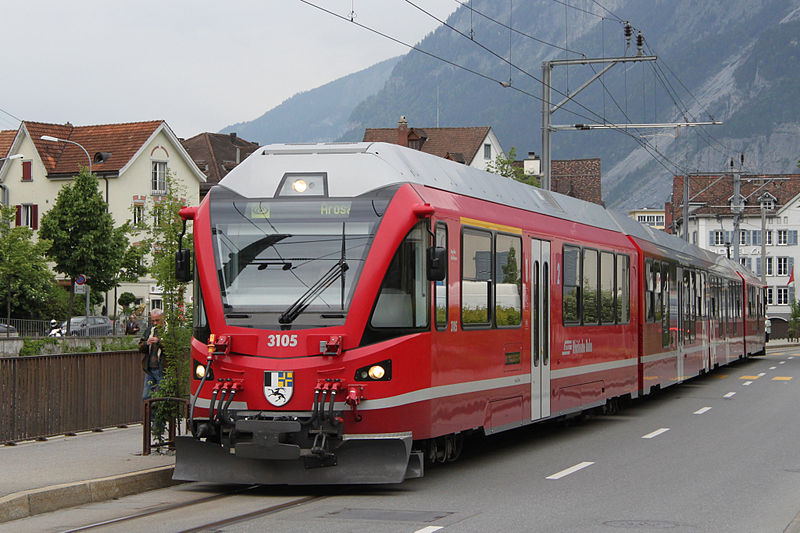There is also the Swiss model of street running with standard trains.
That's similar to a narrow gauge version of the Zwickau model. Note the trains are starting to become more like trams now with skirts getting longer etc, but still no proper road brake and turning lights. Switzerland is fairly unique though and a few years before, that train would have been a standard RhB loco and carriages, even perhaps with a goods wagon attached to the back.
It's this sense of light rail coexisting on or near the street that is the idea the original poster is trying to get at I think. Having vehicles legally classified as being part of a tramway system allows them to negotiate streets clearly, but that doesn't mean they have to follow streets shared with traffic for all or even significant parts of their route, it's just a convenience to allow them to get closer to people and facilities where that's advantageous, and at a more affordable cost.
The freedom to cover short critical sections using level crossing, running along or alongside a street, through a pedestrian square or a park etc, can change accessibility of a new route dramatically compared to standards for normal railways, which in UK the ORR demands must be entirely and fully segregated and must incorporate no new level crossings. Such heavy rail infrastructure is very difficult and expensive to build and especially to fit into an existing urban landscape without tunneling or (often) completely unacceptable elevated structures. it's interesting that many closed branch lines have miles of unobstructed rural alignment, and perhaps only a house or two on the tracks in the towns en route, but it is the reinstatement of an old level crossing next to the station site that might become the key issue that could prevent even any thoughts of reinstatement. Clearly a lengthy alternative alignment might be devised to avoid the road crossing at significant cost, but in finding a new route clear of buildings the line might end up avoiding entirely the natural center and focus of the very settlement it was trying to serve in the first place!
Whether train-tram or tram-train rolling stock is used is largely unrelated to the desire to share some space more intimately with road vehicles or pedestrians, although to conform to tramway regs as per Zwickau or Karlsruhr the trains or trams must be compliant with road vehicle standards of terms of lighting, turn and brake signalling and brake performance I assume. Also behaviour in such tramway sections would be speed limited and crossings would normally be locally monitored by the driver etc.
The choice of tram or train derived rolling stock would mainly be down to minimum curve radius required, and wheel profile issues (which depend on curves to an extent but also the permitted depth and width of flangeways on street). As I explained before, Zwickau RegioSprinter vehicles have to negotiate curves no tighter then 150m radius on the shared street running section in that city. I don't know what their wheel profiles are, but I suspect they are heavy rail standard, which means that on the shared section one side of the small flanged city tramcars are running in a common groove that is much larger in both width and depth than required for its own wheelsets. That's OK, as long as the deep wide grooves are acceptable on the street (they are at existing level crossings clearly). It is full size heavy rail flanges that cannot run in normal tram grooves. In Switzerland the narrow gauge of most of their light railways with some street running intrinsically allows tighter curves which they can exploit to squeeze between buildings in urban sections.
There might be some half way house between (lighter) heavy rail trains and a trams where a heavy rail derived vehicle could be adapted to go round slightly tighter curves (say down to 75m, with wheel profile, bogie and suspension arrangements adjusted accordingly) but not so tight a curve as a conventional tram-train could handle. Combined with limited street running / crossing, such vehicle could allow more flexible route design, especially in the (sub)urban areas in question, but with the characteristics remaining rather closer to normal heavy rail standards, it could also (perhaps) proceed at higher speed than a tram-derived tram-train when on the conventional network.



